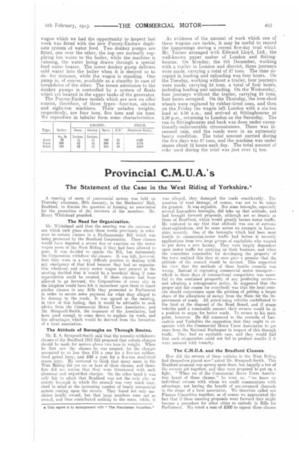Two New Purrey-Exshaw Steamers.
Page 4

Page 5

If you've noticed an error in this article please click here to report it so we can fix it.
First-published Particulars of the New Four-ton and Six-ton Steam Lorries Manukactured in Bordeaux.
Hearing from Mr. D. M. Turner, who is the manager of the London branch of Anciens Etablissements Valentin Purrey, that the unique Finchbuilt steam lorries which he is marketing in this country have been considerabiy modified in capacity, we had arranged with him to inspect one or both of the new machines, when, by fortuitous circumstances, one of the six-tanners drove up to Temple Press warehouses, one day last week, with a load of paper for this journal. This wagon happened to be doing
"one day's work," by way of demonstration, for Haulage Ltd., of York Street, Walworth, which concern contracts for the cartage of the paper used by this journal and its sister publications. We therefore welcomed the opportunity, without further arrangement, to examine the machine.
The three-ton and the five-ton Purrey-Exshaw wagons have now been replaced by four-ton and sixton models, and this alteration was decided upon with a view to making these steamers more suitable to this country's conditions. The three-tonner is now fitted with what was the five-ton generator, and it now becomes a four-ton model, whilst the five-ton model is provided with what was the eight-ton generator, and this now becomes the six-ton model. The fourcylinder, compound engine has been displaced by a i simple one of two cylinders, and these alterations, n conjunction with others of minor importance, have undoubtedly rendered the Purrey-Exshaw machines more simple and yet more powerful than those ratings which they have displaced. Nevertheless, the prices for the new models remain as those of the types of which they have taken the places. it should be remembered that the Purrey-Exshaw system provides for absolute automaticity of water heed and coke supply. The generator, which is, of course, of unique design, consists of a group of tubes proceeding from a lower rectangular collector to an upper cylindrical tank. The generator is of the flash type, and water is raised from the lower collector through the vaporizing tubes, the return being made through two other tubes °I large diameter. The steam produced is gathered in the upper tank. The saturated steam taken from the upper tank is superheated in special superheating tubes, whence it is directed to the upper compartment of the lower collector. Steam passes through the tubes in the contrary direction to the passage of the hot gases, and this practically obviates any risk of subsequent condensation. The method of fuel supply is unique, and is automatic. A coke hopper attached to one side of the generator leads to an inclined fire grate, down which the fuel glides, the residue collecting in a capacious ashpan slung beneath the boiler. In practice this is found to provide an exceedingly simple and trustworthy method of automatic firing. Its provision enables the machine to be controlled by one man.
The earlier models, it will be remembered, had four-cylinder compound tandem-type engines, and now these have been superseded, as we have already remarked, by two-cylinder simple engines. The
wagon. which we had the opportunity to inspect last week was fitted with the new Purrey-Exshaw duplicate system of water feed. Two donkey pumps are fitted, one over the other, the top one normally supplying hot waer to the boiler, while the machine is running, the water being drawn through a special food water heater. The lower donkey pump delivers cold water into the boiler when it is desired so to dofor instance, while the wagon is standing. One pump is, of course, available as a standby in case of kreakdown of the other. The steam admission to the donkey pumps is controlled by a system of floats which are located in the upper tanks of the generator.
The Purrey-Exshaw models which are now on offer consist, therefore, of three types—four-ton, six-ton and eight-ton machines. Their unladen weights, respectively, are four tons, five tons and six tons. We reproduce in tabular form some characteristics.
As evidence of the amountof work which one of these wagons can tackle, it may be useful to record the happenings during a recent five-day trial which Mr. Turner arranged with Edward Lloyd, Ltd., the well-known paper maker of London and Sitting-. bourne. On Monday, the 9th December, working with a trailer in London and district, three journeys were made, carrying a total of 27 tons. The time occupied in loading and unloading was four hours. On the Tuesday, working without a trailer, four journeys were made, carrying 24 tons, a total of four hours, including loading and unloading. On the Wednesday, four journeys without the trailer, carrying 24 tons, four hours occupied. On the Thursday, the iron-shod wheels were replaced by rubber-tired ones, and then on the Friday the wagon left London with a six-ton load at S.30 a.m., and arrived at Sittingbourne at 2.30 p.m., returning to London on the Saturday. The run to Sittingbourne and back was done under exceptionally-unfavourable circumstances. There was incessant rain, and the roads were in an extremely heavy condition. The total amount carried during the five days was B7 tons, and the machine was under steam about 12 hours each day. The total amount of coke used during the trial was just over l ton.






























